Mechanical Properties of Metasandstone under Uniaxial Graded Cyclic Loading and Unloading
Abstract
:1. Introduction
2. Materials and Test Methods
2.1. Rock Sample Preparation
2.2. Test Equipment
2.3. Test Methods
- (1)
- Place the prepared rock sample under the working platform of the material testing machine, start the material testing machine, and make the loading end of the material testing machine slowly approach the upper end of the rock sample.
- (2)
- Start loading, use the force control mode to load the rock sample at the loading rate of 0.50 MPa/s to the preset upper limit value of the level stress, and reach the upper limit value of the level stress. Immediately, the rock sample is unloaded at the unloading rate of 0.50 MPa/s until the axial force is zero, and a complete loading and unloading cycle is completed. In this process, the data recording system and acoustic emission acquisition system of the material testing machine maintain synchronous acquisition throughout the whole process.
- (3)
- After a loading and unloading cycle, measure and record the longitudinal wave data of 5 points (0, 1, 2, 3 and 4) of the rock sample with an ultrasonic collector (Figure 4). If the test piece is macroscopically damaged, this step is terminated.
- (4)
- After the wave velocity measurement at five points of the rock sample is completed, place the metasandstone rock sample back on the working platform of the material testing machine, and prepare to start the loading and unloading test at the next level until the macro instability failure of the rock sample occurs. At this point, the test of a single rock sample is completed, and the test of the next rock sample is started.
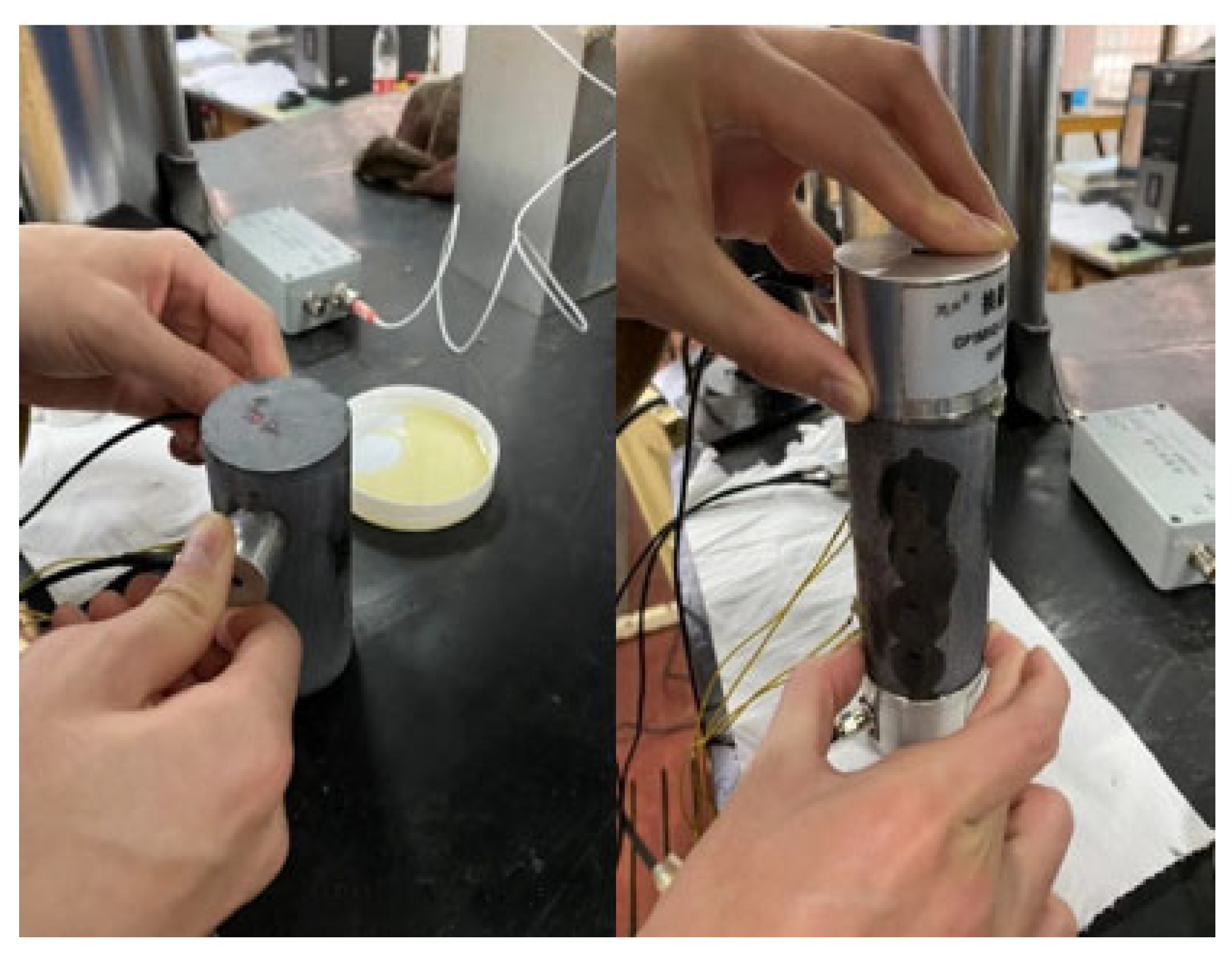
3. Test Results and Analysis
3.1. Mineral Composition Analysis
3.2. Analysis of Rock Failure Characteristics
3.3. Strength Characteristic Analysis
3.3.1. Variation Characteristics of Rock Compressive Strength
3.3.2. Variation Characteristics of Elastic Modulus of Rock
3.4. Acoustic Emission Characteristics Analysis
3.5. Wave Velocity Characteristics Analysis
4. Conclusions
- (1)
- In the uniaxial graded cyclic loading and unloading test, the crack sprouting and development inside the metasandstone samples were higher than those in the uniaxial loading test. The damage pattern of the rock samples had typical fatigue damage characteristics, and the damage pattern was more dispersed when compared with that in the uniaxial loading condition. Compared with the uniaxial loading test, the uniaxial graded cyclic loading and unloading caused more irreversible damage to the interior of the rock samples, which enhanced the plasticity of the metasandstone.
- (2)
- In the uniaxial graded cyclic loading and unloading test, the acoustic emission signals of the metasandstone samples were mainly generated in the loading phase, and almost no acoustic emission activity was generated in the unloading phase. In the uniaxial graded cyclic loading and unloading tests, the Kaiser effect and Felicity effect were evident in the metasandstone samples.
- (3)
- During the last loading process before the damage of metamorphic sandstone samples, the quiet period of acoustic emission occurs. The acoustic emission activity of metasandstone will rise suddenly before the damage, and then drop suddenly. The rock will be damaged soon after the sudden drop. In practical engineering, the quiet period of acoustic emission activity can be used to monitor and predict the instability of rock mass.
- (4)
- There is a stress threshold of wave velocity variation in metasandstone. Below this threshold value, the internal damage of rock sample is weak, and the wave velocity does not decrease significantly with the increase in stress. When the stress exceeds this threshold value, the damage degree of rock will change qualitatively with the increase in stress, and the wave velocity of rock sample will decrease rapidly. The rapid decline in wave velocity can be used to predict the damage of rock mass stability in engineering.
Author Contributions
Funding
Institutional Review Board Statement
Informed Consent Statement
Data Availability Statement
Acknowledgments
Conflicts of Interest
References
- Lemaitre, J.; Chaboche, J.L. Mechanics of Solid Materials; Cambridge University Press: Cambridge, UK, 1990. [Google Scholar]
- Singh, U.K.; Digbyp, J. A continuum damage model for simulation of the progressive failure of brittle rocks. Int. J. Solids Struct. 1989, 25, 647–663. [Google Scholar] [CrossRef]
- Li, C.; Nordlund, E. Experimental verification of the Kaiser effect in rocks. Rock Mech. Rock Eng. 1993, 26, 333–351. [Google Scholar] [CrossRef]
- Wu, L.; Zhou, K.; Gao, F.; Gu, Z.; Yang, C. Research on the Mechanical Characteristics of Cyclic Loading and Unloading of Rock Based on Infrared Thermal Image Analysis. Math. Probl. Eng. 2021, 2021, 5578629. [Google Scholar] [CrossRef]
- Zhang, M.; Meng, Q.; Liu, S.; Qian, D.; Zhang, N. Impacts of Cyclic Loading and Unloading Rates on Acoustic Emission Evolution and Felicity Effect of Instable Rock Mass. Adv. Mater. Sci. Eng. 2018, 2018, 8365396. [Google Scholar] [CrossRef] [Green Version]
- Wang, H.; Li, J.; Wen, Z. Mechanical Behavior Evolution and Damage Characterization of Coal under Different Cyclic Engineering Loading. Geofluids 2020, 2020, 8812188. [Google Scholar] [CrossRef]
- Wang, T.; Wang, C.; Xue, F.; Wang, L.; Teshome, B.H.; Xue, M. Acoustic Emission Characteristics and Energy Evolution of Red Sandstone Samples under Cyclic Loading and Unloading. Shock Vib. 2021, 2021, 8849137. [Google Scholar] [CrossRef]
- Guo, J.; Feng, G.-R.; Qi, T.-Y.; Wang, P.; Yang, J.; Li, Z.; Bai, J.; Du, X.; Wang, Z. Dynamic Mechanical Behavior of Dry and Water Saturated Igneous Rock with Acoustic Emission Monitoring. Shock Vib. 2018, 2018, 2348394. [Google Scholar] [CrossRef] [Green Version]
- Wang, K.; Li, X.; Huang, Z.; Zhao, M. Experimental Study on Acoustic Emission and Resistivity Response of Sandstone under Constant Amplitude Cyclic Loading. Adv. Mater. Sci. Eng. 2021, 2021, 6637200. [Google Scholar] [CrossRef]
- Wu, J.; Wang, E.; Ren, X.; Zhang, M. Size effect of concrete specimens on the acoustic emission characteristics under uniaxial compression conditions. Adv. Mater. Sci. Eng. 2017, 2017, 7652313. [Google Scholar] [CrossRef]
- Liang, D.; Zhang, N.; Rong, H. An experimental and numerical study on acoustic emission in the process of rock damage at different stress paths. Geofluids 2021, 2021, 8047755. [Google Scholar] [CrossRef]
- Gong, F.; Yan, J.; Wang, Y.; Luo, S. Experimental Study on Energy Evolution and Storage Performances of Rock Material under Uniaxial Cyclic Compression. Shock Vib. 2020, 2020, 6637200. [Google Scholar] [CrossRef]
- Pei, F.; Ji, H.; Zhao, J.; Geng, J. Energy Evolution and AE Failure Precursory Characteristics of Rocks with Different Rockburst Proneness. Adv. Civ. Eng. 2020, 2020, 8877901. [Google Scholar] [CrossRef]
- Zhao, G.; Wang, C.; Liang, D. Comparative experimental studies of acoustic emission characteristics of sandstone and mudstone under the impacts of cyclic loading and unloading. Int. J. Distrib. Sens. Netw. 2018, 14, 467611360. [Google Scholar] [CrossRef] [Green Version]
- Meng, Q.; Chen, Y.; Zhang, M.; Han, L.; Pu, H.; Liu, J. On the Kaiser Effect of Rock under Cyclic Loading and Unloading Conditions: Insights from Acoustic Emission Monitoring. Energies 2019, 12, 3255. [Google Scholar] [CrossRef] [Green Version]
- Li, J.; Hong, L.; Zhou, K.; Xia, C.; Zhu, L. Limestone Acoustic Emission Evolution Characteristics Under Different Experimental Loading and Unloading Conditions. Front. Phys. 2020, 8, 590710. [Google Scholar] [CrossRef]
- Saroglou, C.; Kallimogiannis, V. Fracturing process and effect of fracturing degree on wave velocity of a crystalline rock. J. Rock Mech. Geotech. Eng. 2017, 9, 797–806. [Google Scholar] [CrossRef]
- Ding, Q.; Song, S.; Pia, G. Experimental Investigation of the Relationship between the P-Wave Velocity and the Mechanical Properties of Damaged Sandstone. Adv. Mater. Sci. Eng. 2016, 7654234. [Google Scholar] [CrossRef] [Green Version]
- Liu, Y.; Qiao, L.; Li, Y.; Ma, G.; Golosov, A.M.; Gong, F. Ultrasonic Spectrum Analysis of Granite Damage Evolution Based on Dry-Coupled Ultrasonic Monitoring Technology. Adv. Civ. Eng. 2020, 2020, 8881800. [Google Scholar] [CrossRef]
- Li, H.; Dong, Z.; Ouyang, Z.; Liu, B.; Yuan, W.; Yin, H. Experimental Investigation on the Deformability, Ultrasonic Wave Propagation, and Acoustic Emission of Rock Salt Under Triaxial Compression. Appl. Sci. 2019, 9, 635. [Google Scholar] [CrossRef] [Green Version]
- Xiao, P.; Zheng, J.; Dou, B.; Tian, H.; Cui, G.; Kashif, M. Mechanical Behaviors of Granite after Thermal Shock with Different Cooling Rates. Energies 2021, 14, 3721. [Google Scholar] [CrossRef]
- Liu, X.; Wang, X.; Wang, E.; Liu, Z.; Xu, X. Study on ultrasonic response to mechanical structure of coal under loading and unloading condition. Shock. Vib. 2017, 2017, 7643451. [Google Scholar] [CrossRef] [Green Version]
- Kaiser, E.J. A Study of Acoustic Phenomena in Tensile Test. Ph.D. Thesis, Technische Hochschule München, München, Germany, 1953. [Google Scholar]
- Goodman, R.E. Subaudible noise during compression of rock. Geol. Soc. Am. Bull. 1963, 74, 487–490. [Google Scholar] [CrossRef]
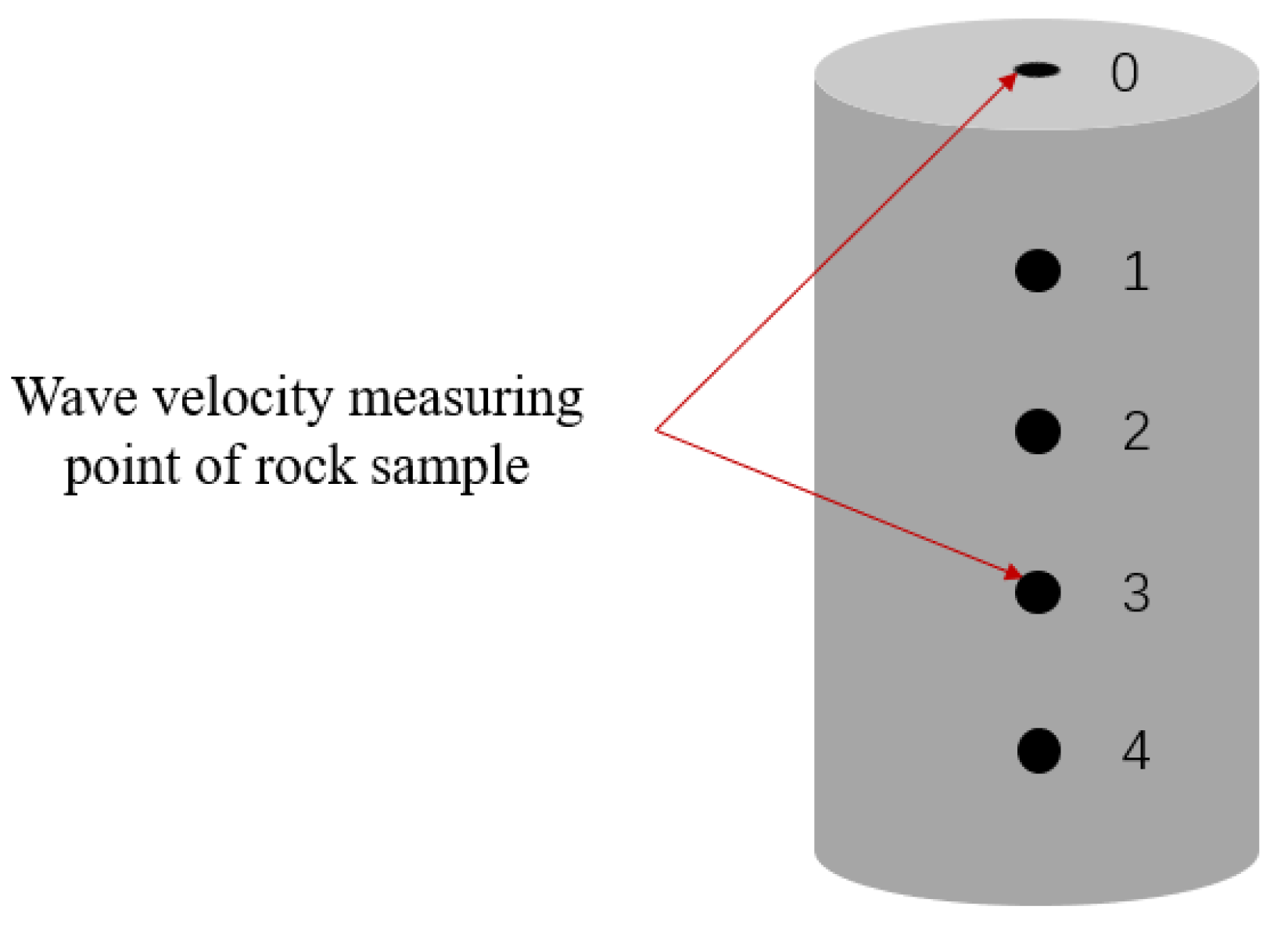
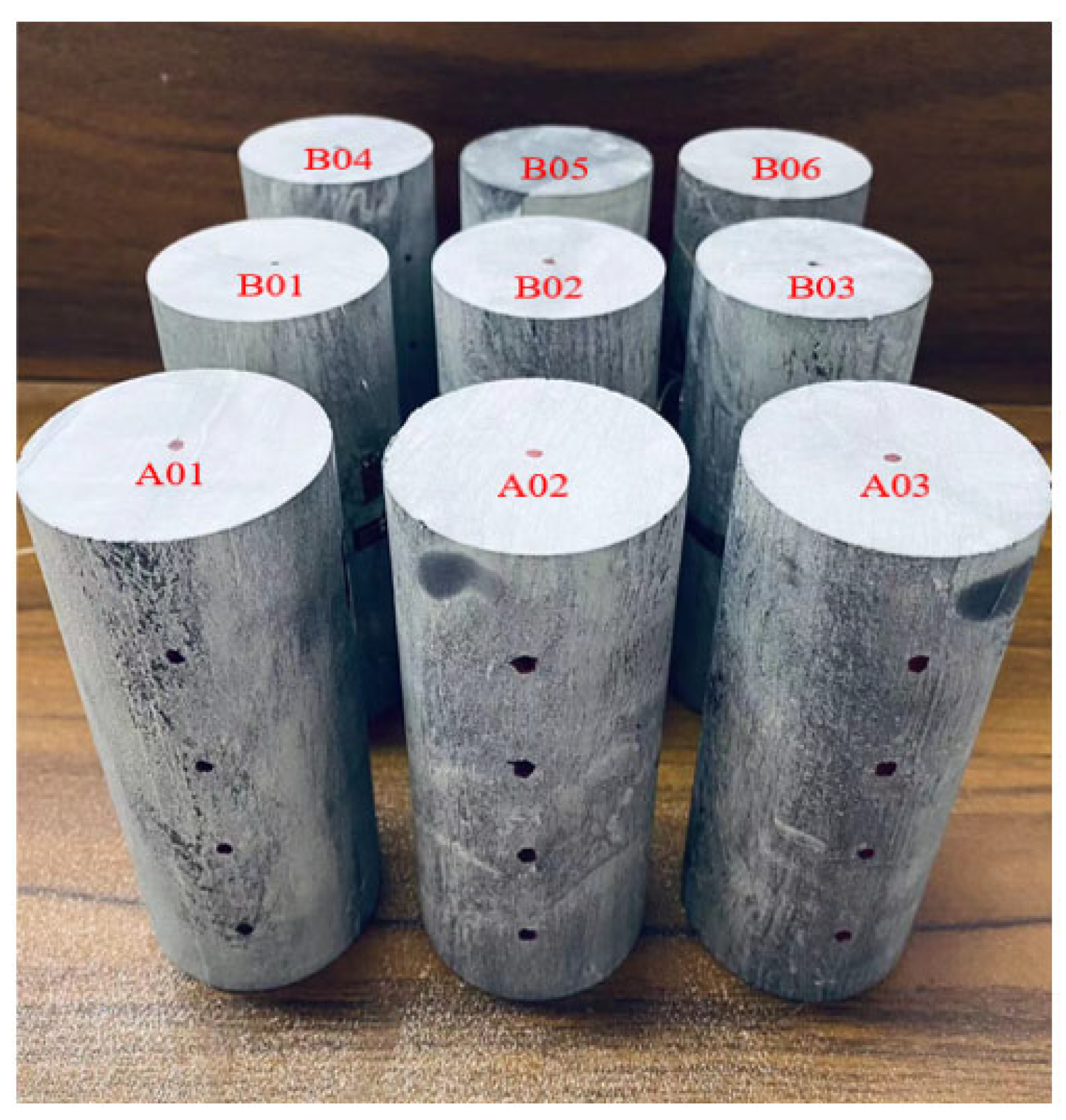


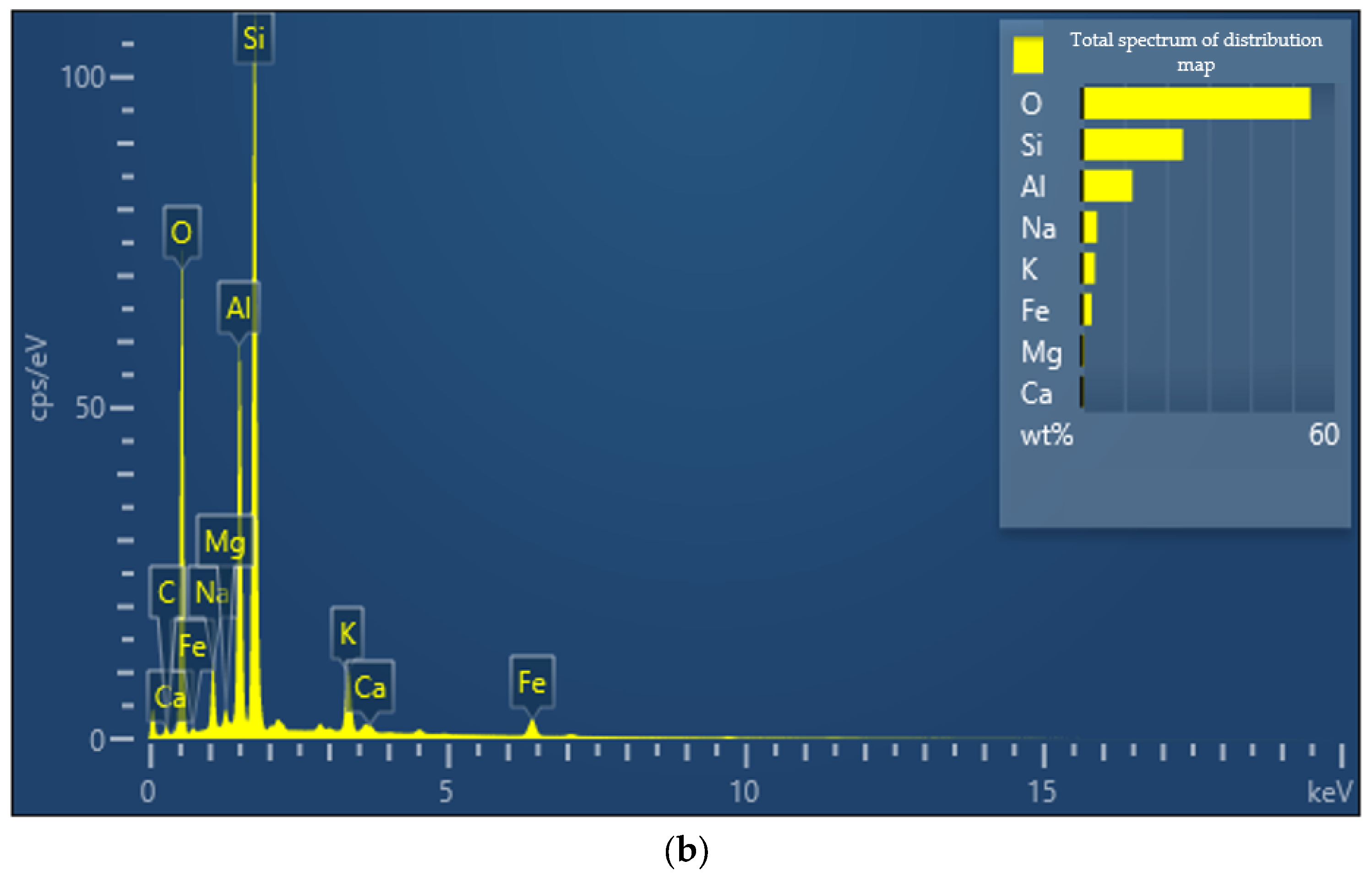
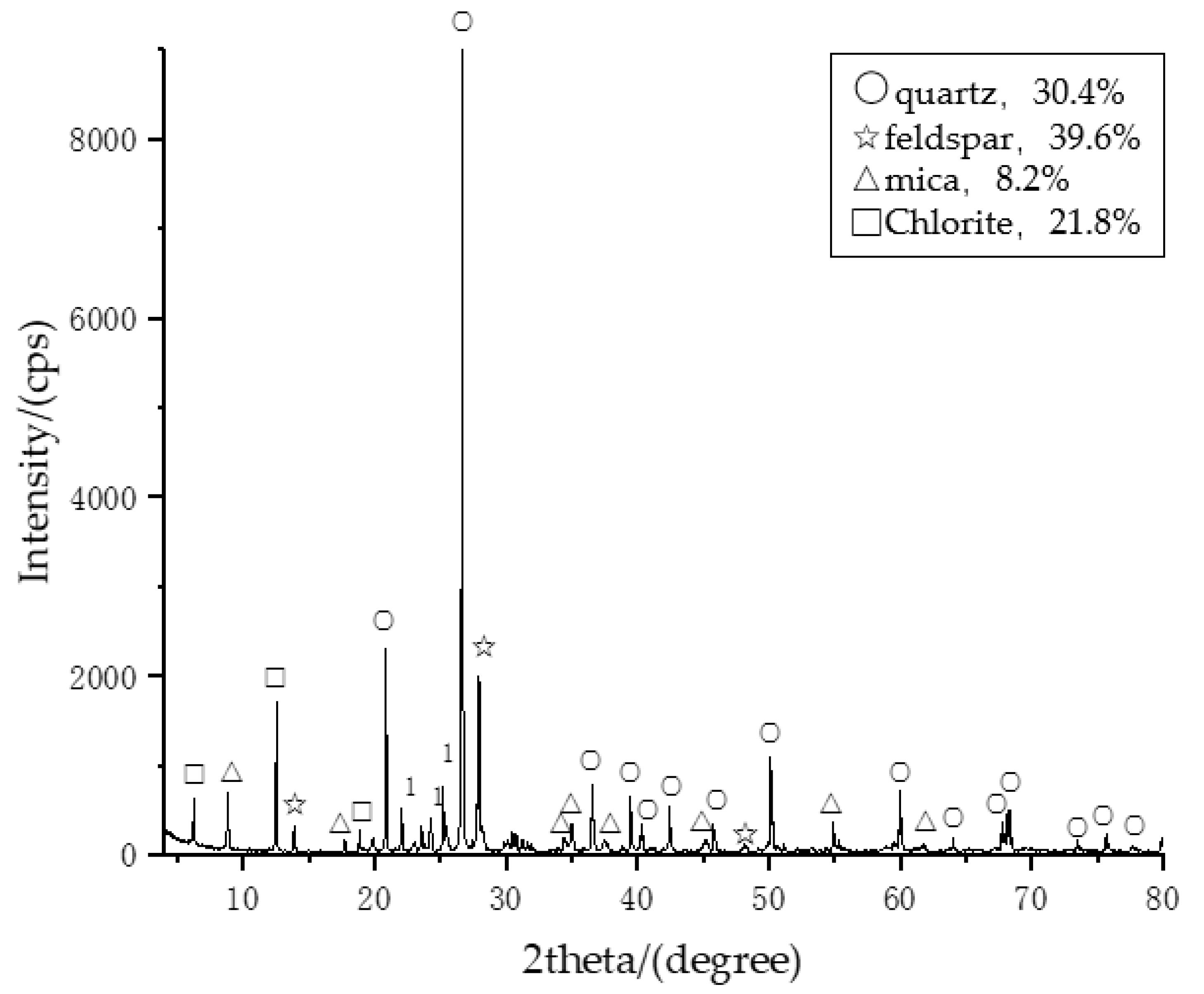

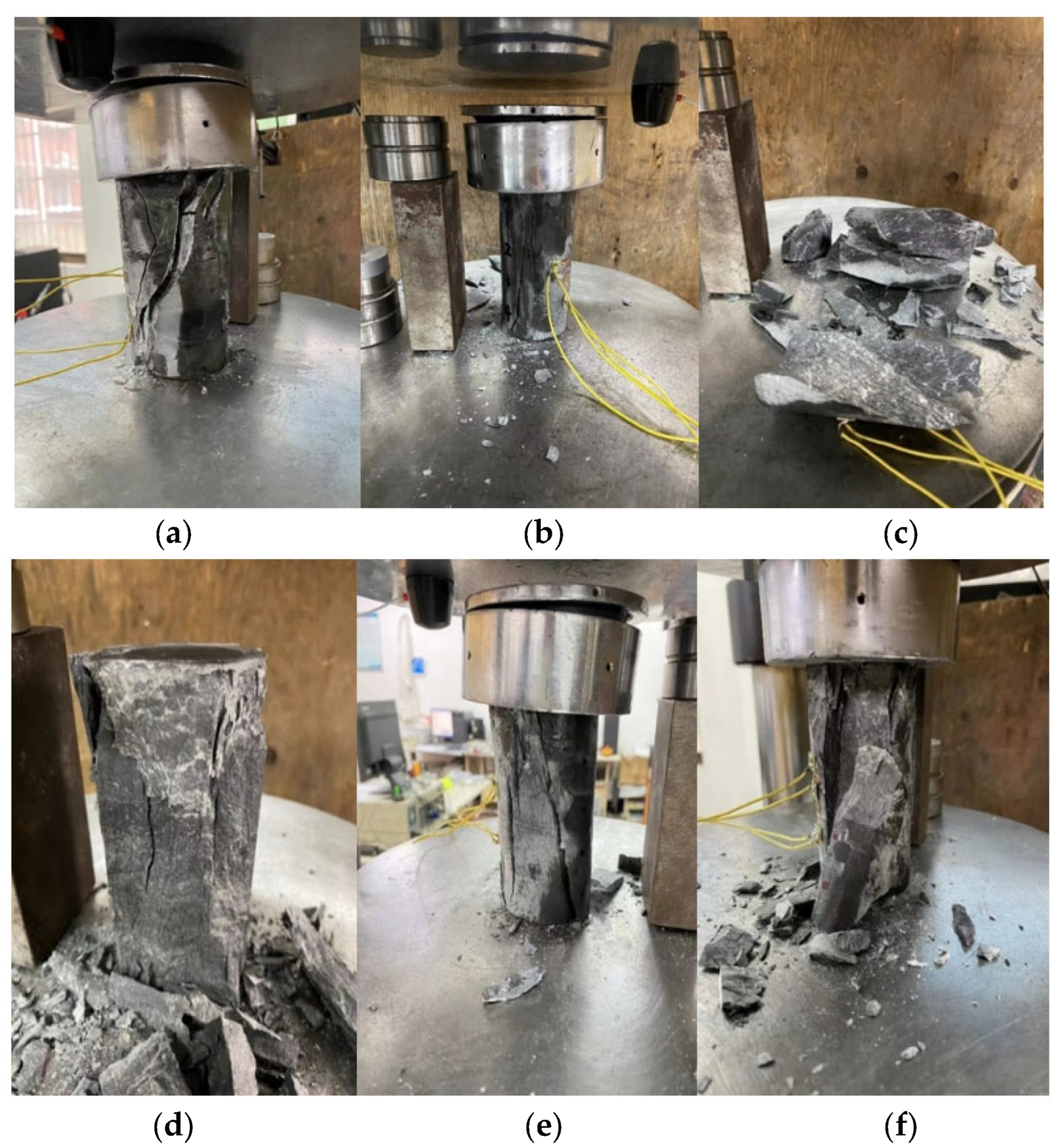
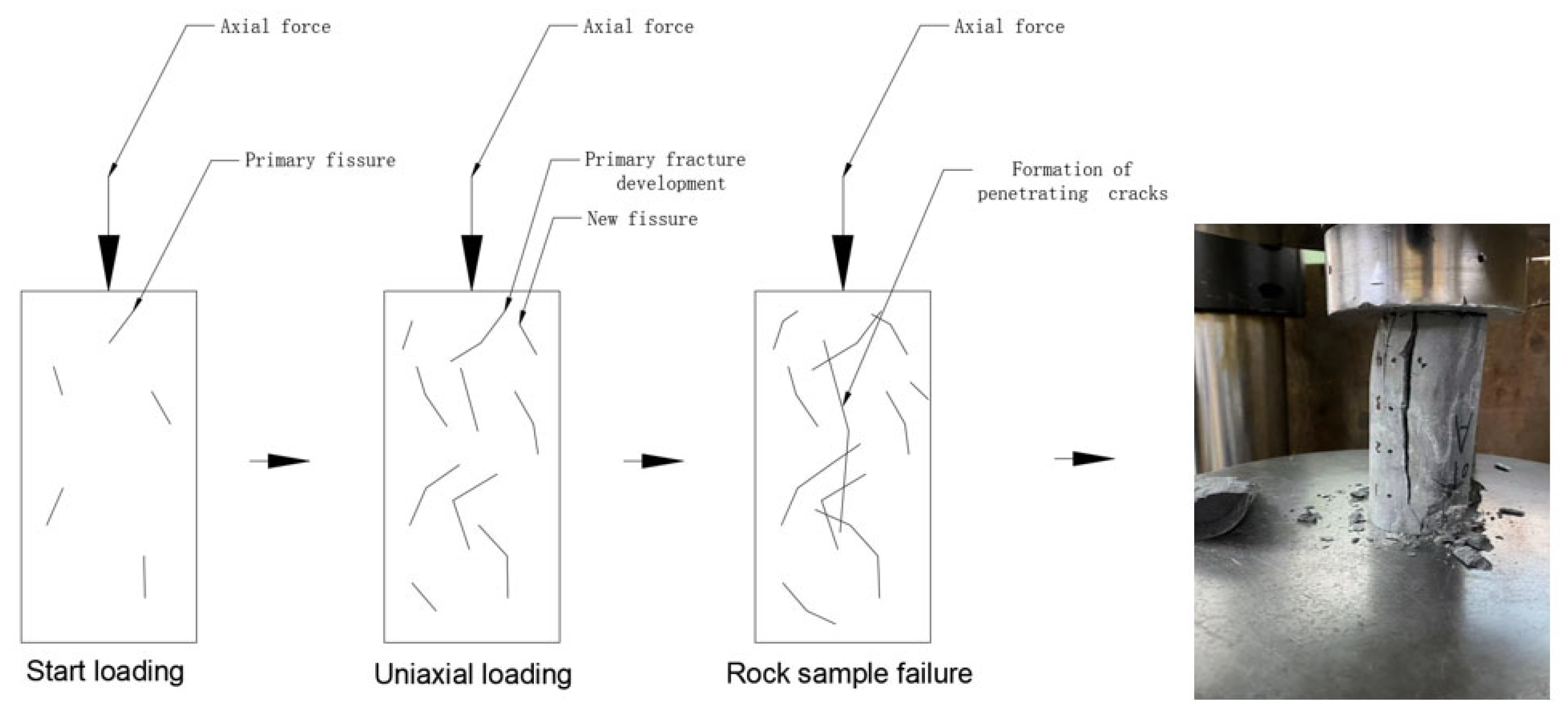
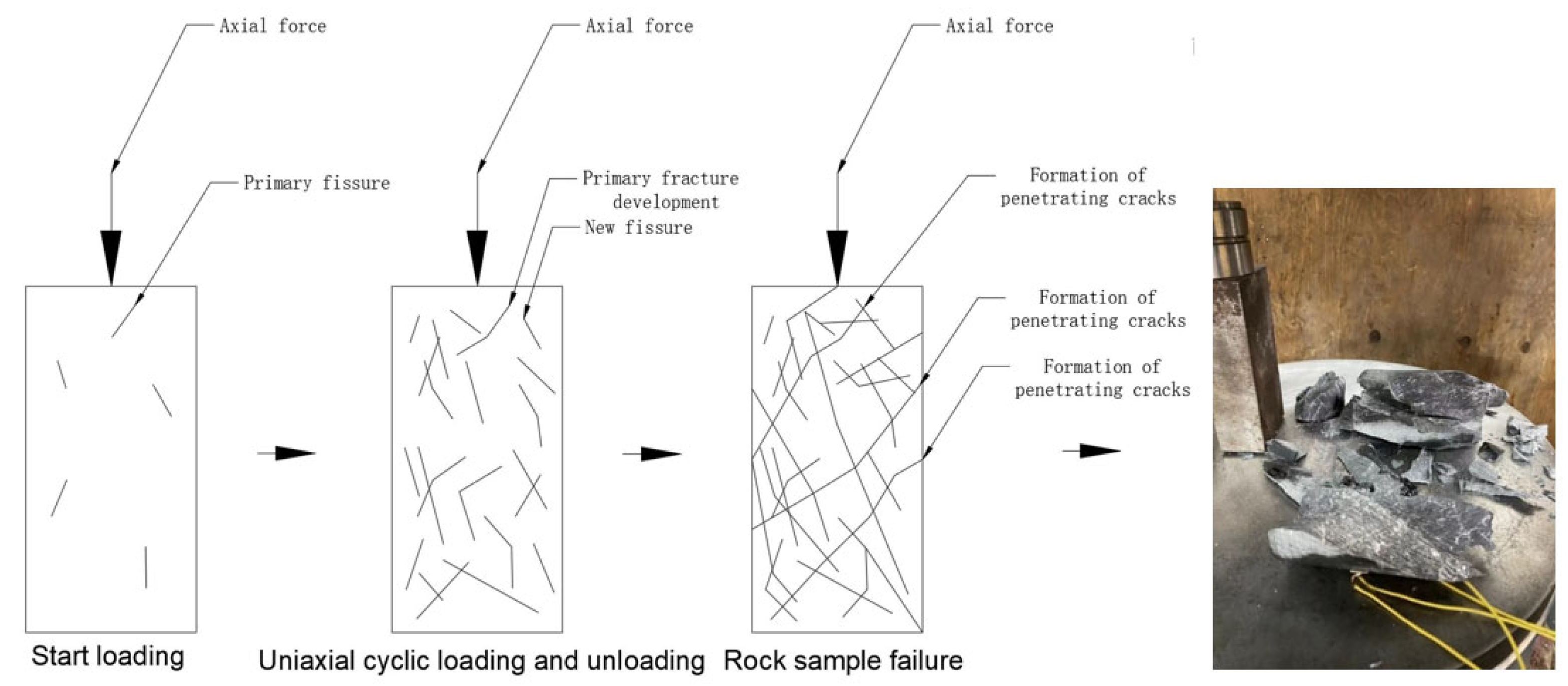
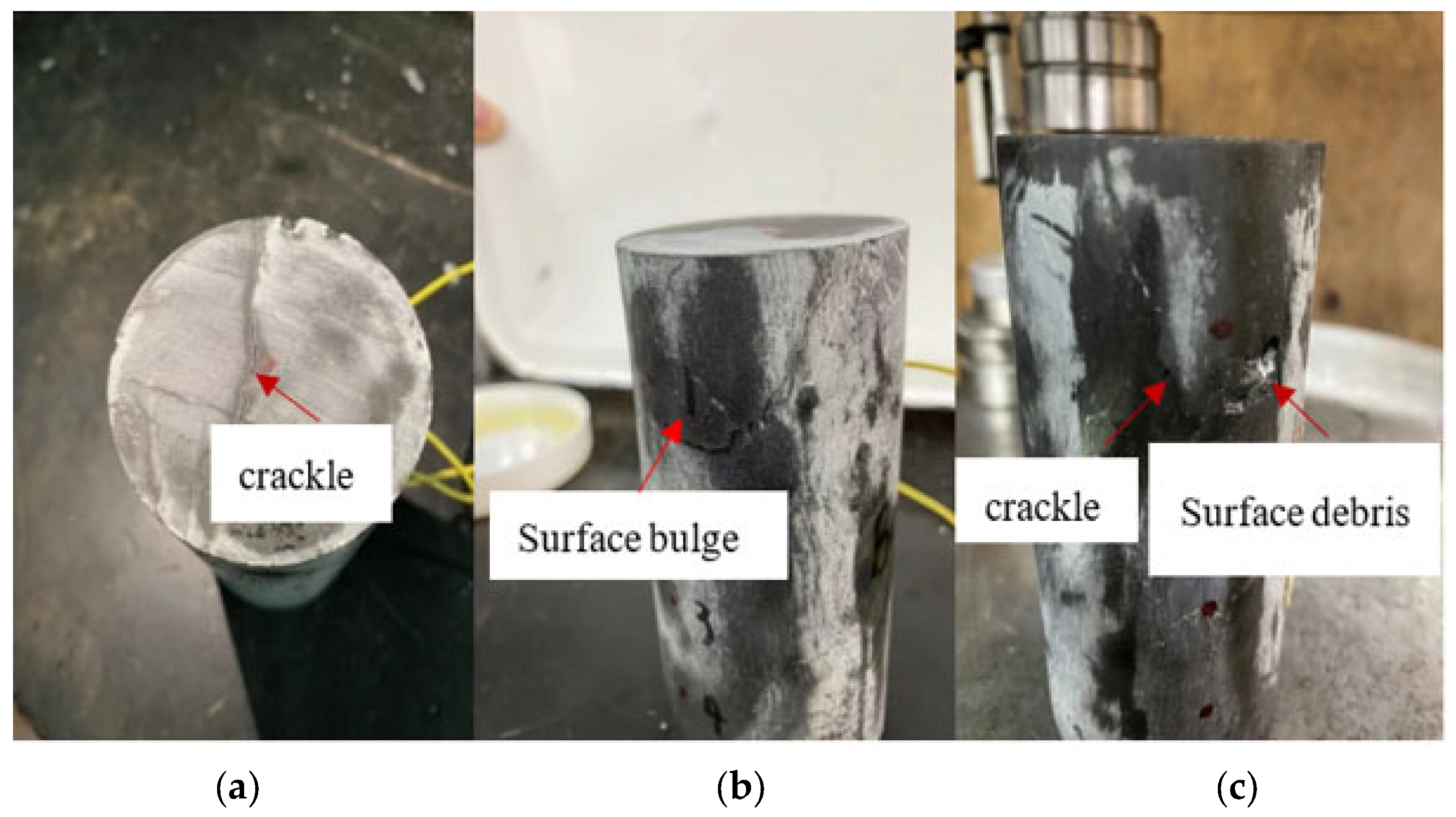
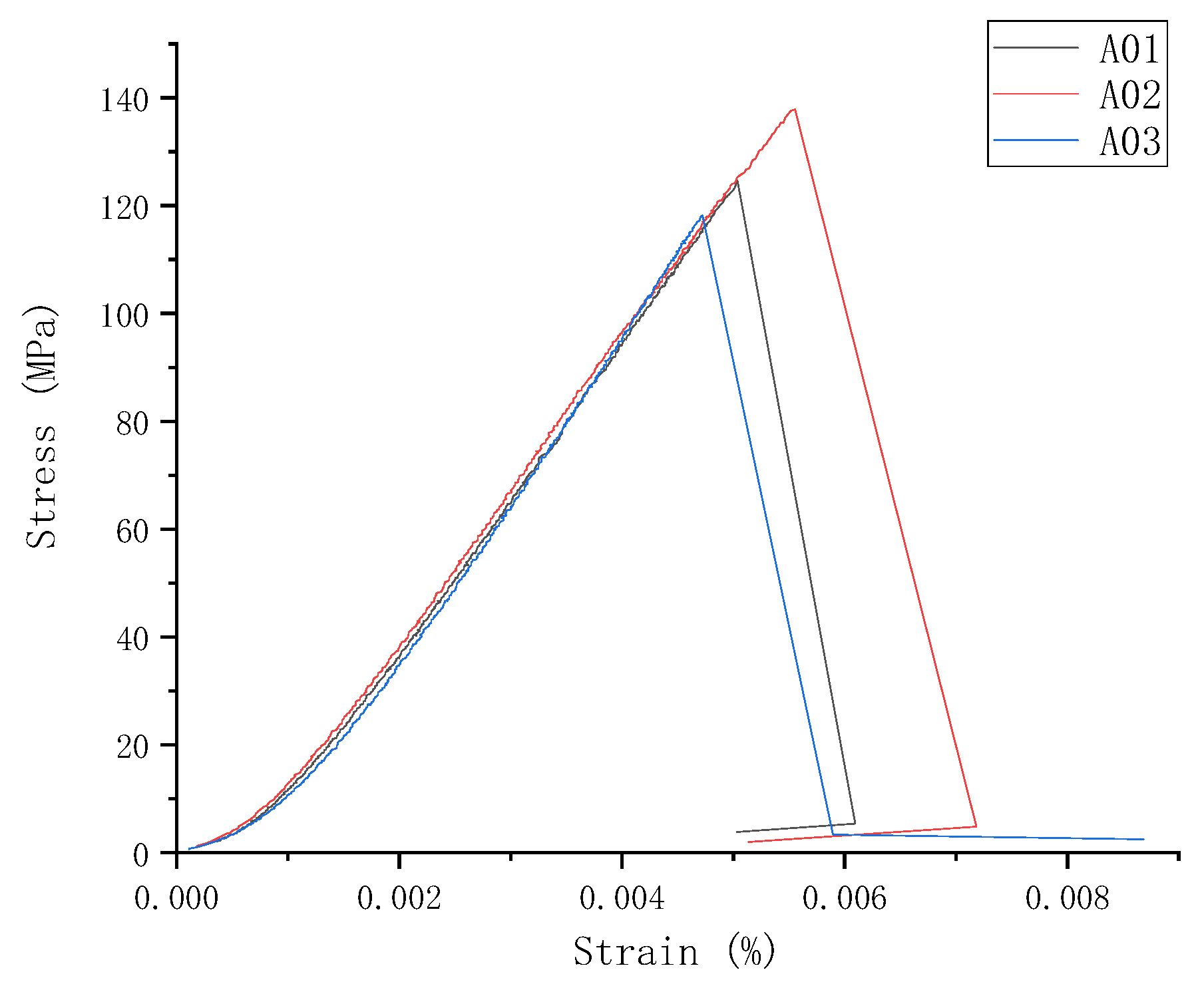

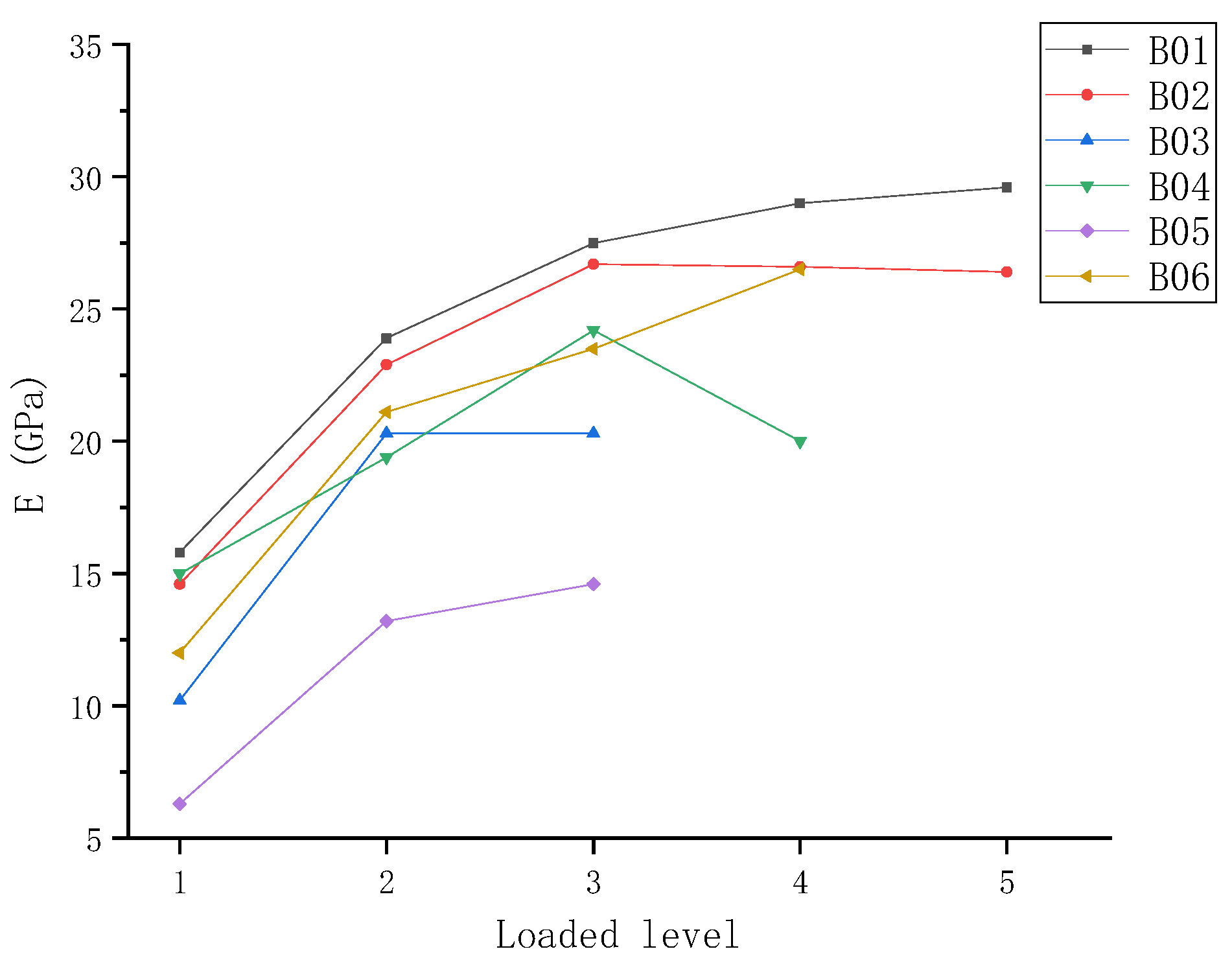

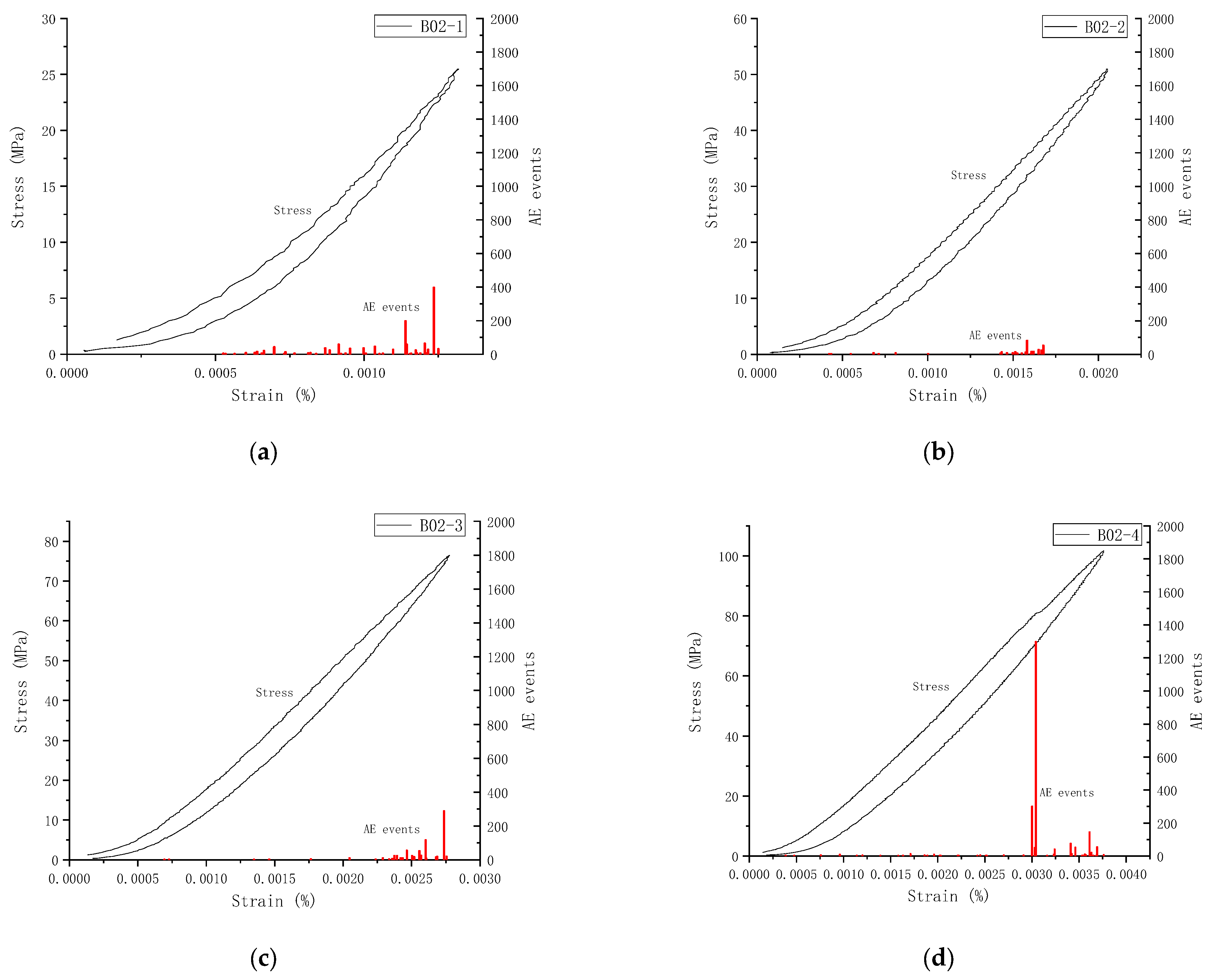
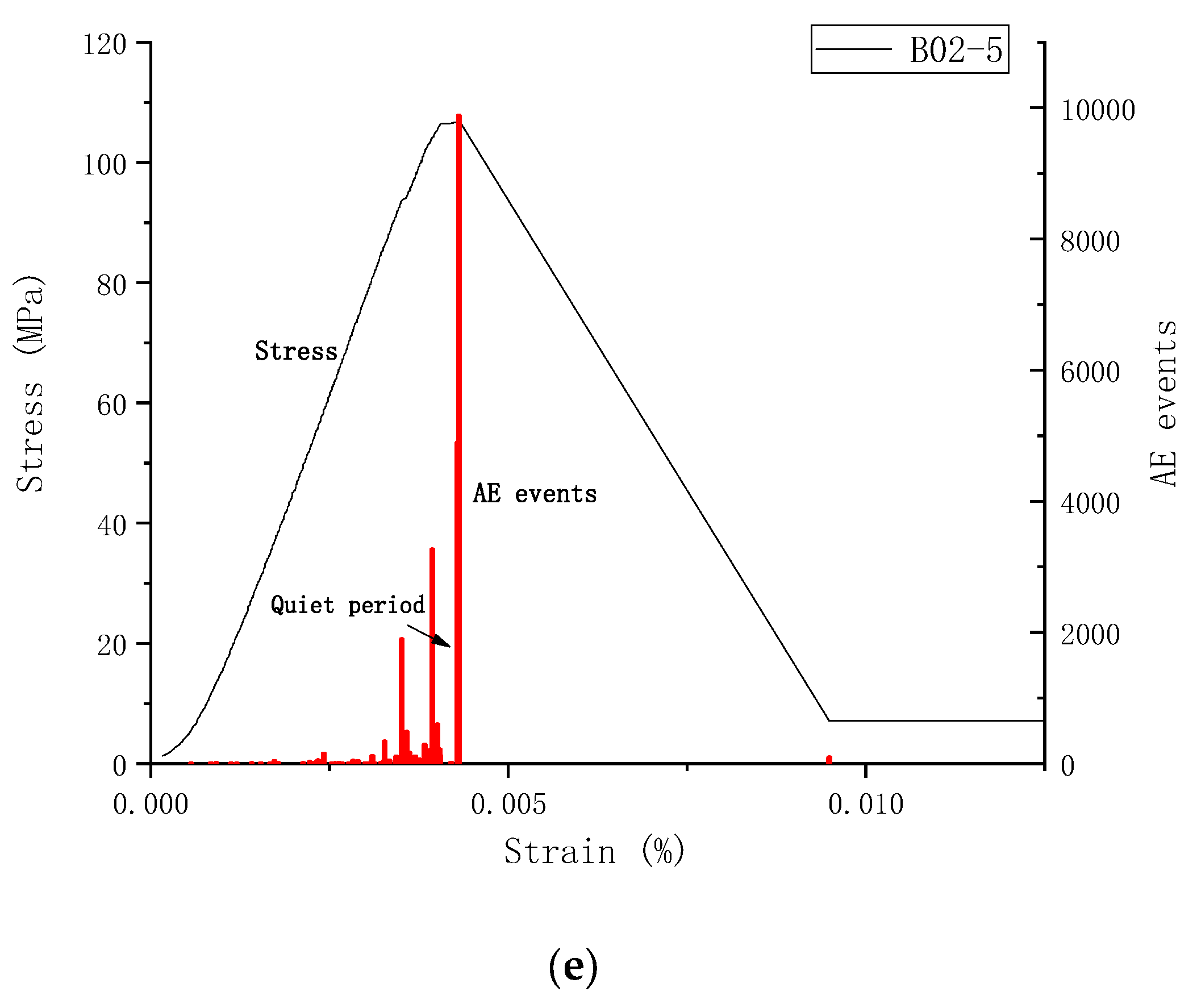
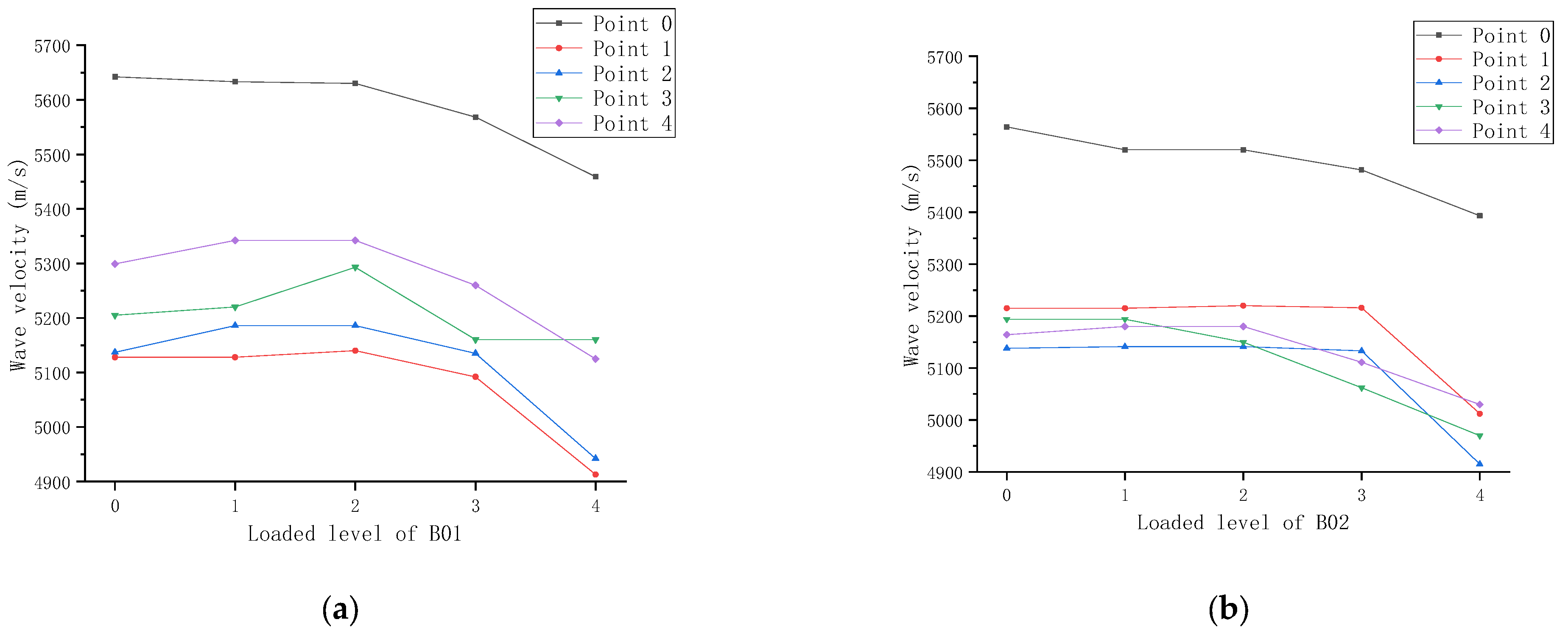

| Test Items | Rock Samples | Height/mm | Diameter/mm | Average Wave Velocity/m·s−1 |
|---|---|---|---|---|
| Uniaxial compression | A01 | 99.85 | 50.11 | 5247 |
| A02 | 100.29 | 49.89 | 5305 | |
| A03 | 100.18 | 50.23 | 5266 | |
| Uniaxial staged cyclic loading and unloading | B01 | 99.92 | 49.90 | 5282 |
| B02 | 100.04 | 49.96 | 5255 | |
| B03 | 100.11 | 49.83 | 5141 | |
| B04 | 100.15 | 49.97 | 5149 | |
| B05 | 100.12 | 50.03 | 5115 | |
| B06 | 100.21 | 49.99 | 5182 |
| Rock Samples | UCS/MPa | E/GPa | R0/MPa | E0/GPa |
|---|---|---|---|---|
| A01 | 124.6 | 29.9 | ||
| A02 | 137.9 | 28.8 | 126.9 | 29.8 |
| A03 | 118.2 | 30.8 |
| Rock Samples | Number of Complete Cycles | UCS/MPa | E/GPa | Rb/MPa | Eb/GPa |
|---|---|---|---|---|---|
| B01 | 4 | 110.5 | 29.6 | ||
| B02 | 4 | 107.1 | 26.4 | ||
| B03 | 2 | 67.8 | 20.3 | 87.4 | 22.9 |
| B04 | 3 | 90.9 | 20.0 | ||
| B05 | 2 | 55.5 | 14.6 | ||
| B06 | 3 | 92.7 | 26.5 |
| Rock Samples | Point 0 | Point 1 | Point 2 | Point 3 | Point 4 |
|---|---|---|---|---|---|
| B01 | 5642 | 5128 | 5137 | 5205 | 5299 |
| B02 | 5564 | 5215 | 5138 | 5194 | 5164 |
| B03 | 5456 | 5142 | 4987 | 5070 | 5051 |
| B04 | 5513 | 5108 | 4972 | 5051 | 5100 |
| B05 | 5410 | 5112 | 5163 | 5008 | 4950 |
| B06 | 5525 | 5092 | 5154 | 5123 | 5017 |
| Rock Samples | Initial Wave Velocity/m·s−1 | Final Wave Velocity/m·s−1 | Decline Ratio/% | Ratio Mean/% |
|---|---|---|---|---|
| B01 | 5192 | 5035 | 3.0 | |
| B02 | 5178 | 4982 | 3.8 | |
| B03 | 5063 | 4819 | 4.8 | 3.7 |
| B04 | 5058 | 4906 | 3.0 | |
| B05 | 5042 | 4828 | 4.2 | |
| B06 | 5097 | 4923 | 3.4 |
| Rock Samples | Initial Wave Velocity/m·s−1 | Final Wave Velocity/m·s−1 | Decline Ratio/% | Ratio Mean/% |
|---|---|---|---|---|
| B01 | 5642 | 5459 | 3.2 | |
| B02 | 5564 | 5393 | 3.1 | |
| B03 | 5455 | 5240 | 3.9 | 3.1 |
| B04 | 5513 | 5375 | 2.5 | |
| B05 | 5410 | 5217 | 3.6 | |
| B06 | 5525 | 5395 | 2.4 |
Publisher’s Note: MDPI stays neutral with regard to jurisdictional claims in published maps and institutional affiliations. |
© 2022 by the authors. Licensee MDPI, Basel, Switzerland. This article is an open access article distributed under the terms and conditions of the Creative Commons Attribution (CC BY) license (https://creativecommons.org/licenses/by/4.0/).
Share and Cite
Liu, D.; Jiang, S.; Tang, Y. Mechanical Properties of Metasandstone under Uniaxial Graded Cyclic Loading and Unloading. Appl. Sci. 2022, 12, 6310. https://doi.org/10.3390/app12136310
Liu D, Jiang S, Tang Y. Mechanical Properties of Metasandstone under Uniaxial Graded Cyclic Loading and Unloading. Applied Sciences. 2022; 12(13):6310. https://doi.org/10.3390/app12136310
Chicago/Turabian StyleLiu, Dunwen, Shulin Jiang, and Yu Tang. 2022. "Mechanical Properties of Metasandstone under Uniaxial Graded Cyclic Loading and Unloading" Applied Sciences 12, no. 13: 6310. https://doi.org/10.3390/app12136310
APA StyleLiu, D., Jiang, S., & Tang, Y. (2022). Mechanical Properties of Metasandstone under Uniaxial Graded Cyclic Loading and Unloading. Applied Sciences, 12(13), 6310. https://doi.org/10.3390/app12136310






